Over two months ago I returned from being away on vacation with a friend in New Zealand and Australia for 3.5 weeks. In case you also want to follow that really fun trip, here's a link to the newest blog: www.bergersadventures7.blogspot.com
After spending several days in charming Coimbra, we got the train north to Porto, a city that is synonymous internationally with the port wine that ages on its riverbanks. I read that not long ago Porto was a pretty distressed industrial city but has undergone a cultural renaissance over the past ten years. That was helped by an infusion of funds from the European Union funding a revamping of the public transportation system, infrastructure and more. Tourism has taken off in a huge way as a result of cheap flights from Britain and the continent so that Porto and the rest of Portugal has become a huge 'go to place.'
After lugging our bags up to our pretty third floor apartment located in the heart of the city, we set out to explore the city, admiring the beautiful tile work along the way.
After spending several days in charming Coimbra, we got the train north to Porto, a city that is synonymous internationally with the port wine that ages on its riverbanks. I read that not long ago Porto was a pretty distressed industrial city but has undergone a cultural renaissance over the past ten years. That was helped by an infusion of funds from the European Union funding a revamping of the public transportation system, infrastructure and more. Tourism has taken off in a huge way as a result of cheap flights from Britain and the continent so that Porto and the rest of Portugal has become a huge 'go to place.'
After lugging our bags up to our pretty third floor apartment located in the heart of the city, we set out to explore the city, admiring the beautiful tile work along the way.
More about the attractive blue-tiled Church of Ildefonso in a later post.
At the bottom of the main street, Avenue of the Allies, named for the alliance created when Portugal joined what turned out to be the winning side before the start of WW I, was Liberty Square. According to travel writer Rick Steves, the statue honored King Pedro IV, a hero in the country's Civil War, who was a proponent for a limited constitutional monarchy in Portugal while still maintaining his role as Emperor Brazil. Known as the people's king, he literally left his heart in Porto - it's buried in a local church!
The king prevailed as you can see by his holding the constitution to prove it!
Facing the square was the huge City Hall instead of a church that would have been normal to see before the secular king confiscated church property in the 1830s and large tracts of church land became the domain of the people.
Behind the trees on the left was the Imperial McDonald's, one of the fanciest in Europe and named after the former Imperial Cafe.
The wide boulevard was lined with elaborate buildings from the Art Deco and Art Nouveau eras, including this fancy Unic Bank. As we neared it, we saw many protesters with signs who obviously had concerns with the bank's practices.
We were caught off guard coming from the stately square walking immediately uphill along the gritty Rua Fabrica named for the tobacco factories that were once here. Many of the storefronts had been boarded up.
Further up the street was the Grande Hotel de Paris Residencial, a once classic but now seedy spot whose claim to fame was that it was the first Porto hotel to have running water in its rooms.
What was very appealing, however, were the tiled buildings that seemed to be a common feature in Porto.
The street opened up into a cute little triangular square named after a firefighter who led a brigade that contained an 1888 fire that may otherwise have devastated the city.
We stopped for a few moments to peruse the pastry offerings at Padaria Ribeiro, a local favorite.
Just a block away was another square, Praca de Gomes Teixeira, named for the first rector of the University of Porto that was founded in 1911 and was the country's second largest. The centerpiece of the square was the Fountain of Lions.
Behind it was the university's main building.
On the other side of the square was the Art Deco-style Armazens Cunhas department store, a style that became popular in Porto in the early 20th century. The store's motto was "We sell for cheaper." The store windows had the dowdiest clothes and accessories that wouldn't even merit a second glance in most cities.
At the end of the square was the Carmo Church, built in the second half of the 18th century, with its brilliant blue azuelos or tiles on the side which depicted the founding of the Carmelite Order.
What a magnificent tiled panel!
We didn't realize until we got closer that there were actually two churches in one: the main Carmo church inhabited by friars that we'd first seen and then the Church of the Carmelitas that once was for a order of Carmelite nuns. The two were connected by what the city promoted as being "the world's narrowest house." Steves stated it allowed the nuns and friars to stay in their spiritual sanctuary without having to go outside.
An information panel, however, informed us the Hidden House was built in 1768 and that various chaplains lived there but there was no mention of nuns ever living there. For shorter periods of time, artists and physicians lived in the tiny abode who were contracted to perform certain services for the Order or its hospital.
In later years, it was occupied by the Sacristan or church caretaker. It was also used for meetings during more turbulent times when more discretion and some secrecy was required as, for example, during the French Invasions from 1897-1811, the Liberalism movement from 1828-1834 and the persecution of religious orders after the proclamation of the Republic in 1910.
Because it was so narrow, there was only room per floor.
There was very little to the kitchen.
Looking down from the top floor:
It seemed inconceivable to me that at one time a caretaker, his wife and nine children lived in this minuscule place!
We couldn't enter the churches then so we decided to return after exploring more in the area. Steven decided to wait for me as I was so curious to pop into Livraria Lello, a bookstore that first opened in 1881 before moving to its present location in 1906. Since then, it has been the "house for men of arts and letters, an inspiration for acclaimed authors, a place for social gatherings, etc." In an article about the Coolest Bookstores from Around the World, TIME Magazine said "Rumor has it that J.K. Rowling was inspired by Livraria Lello while writing Harry Porter (and teaching English) in Porto." I admit to not having read her wildly popular series of books but understand that the bookstore's interior reminds many of something seen on Diagon Alley.
As the Harry Potter connection was attracting 2,000 people to simply ogle the interior without buying anything, it became too much for the small store to handle. As a result, visitors are now required to purchase a pass to enter. Some of the money raised went toward restoring the store's lacy facade.
Apparently the store's design inspired Dumbledore's office in the movies. Even without being a Harry Potter fan, I was entranced by the store's staircase and the entire store.
I, like many others that day, ogled the lovely stained-glass ceiling with the store's monogram and motto Decus in labore which, thanks to my five years of high school Latin and Google, meant dignity at work!
Some people might consider it in poor taste to see a bookstore turned into a theme park for tourists just staring and leaving but I didn't mind one iota supporting such a famous independent bookstore and wonderful tourist attraction in Porto.
The Art Nouveau interior looked like wood but was actually painted plaster with gold leaf!
The tracks on the floor allowed for books in carts to be moved more easily!
Across the street from the bookstore was the unusual Praca de Lisboa, an elevated grassy park because it was built on top of a parking garage of all things - what an ingenious use of space!
They'd even gotten olive trees to grow there.
After relaxing in the park for a bit, we made our way across it to Clerigos Church and Tower which showed the ambitious Italian architect's unusual flair by placing the tower at the back on the higher ground to reinforce its height.
Prince Henry the Navigator who hailed from Porto was shown on the tower.
To enter the church, we had to walk all the way around it. We so rarely have a chance of seeing churches with oval-shaped naves that the interior of the Clerigos Church caught my fancy right away. It was built out of granite and marble but then covered with ornate carvings.
The high altar looked just like a wedding cake with Mary perched at the top, something we're not likely to see again!
The elaborate Sacristy:
Steven took a break by resting in the church while foolish me decided to climb all 225 steps to the top of the tower, little knowing that I was going to be waylaid by all sorts of church collections on the way up. They were of moderate interest but I was determined to make it to the top and not just stop and admire the paintings of benefactors in the Assembly House, the items in the Registry, items brought back by Portuguese explorers in the Coffer, etc.
Views of the interior of the church from an upper level:
I could spot Steven way down there but of course he didn't know to look up and see me!
The 18th century Holy Thursday Urn was designed by Nicolau Nasconi, the church architect.
The stairway to the top sure wasn't suitable for people who had a fear of closed spaces or were behind a long, slow line of visitors as it was one way only.
Oops, another detour, this one to images and iconography from the Middle Ages and Images of Christ from all over the world:
As in Lisbon, trolleys have long been a part of Porto's history since they were invented in the US in 1832. The first trolleys in Iberia made their appearance in Porto 40 years later when they were pulled by horses and oxen. They were dubbed americanos because of their origin.
I was sorry Steven wasn't with me to see the splendid views of Porto, including the elevated park, from the tower.
I could just imagine how marvelous these views would have been on a clear summer day. My view of the Old Cathedral would have to suffice until we visited it a couple of days later.
I slowly made my way down thankful it wasn't at the height of the tourist season.
I was really glad I'd climbed to the top of the tower and enjoyed the unexpected benefit of the church's art collection but relieved to be back on solid ground and with Steven again.
Clearly, the area around the church was still in need of funding for restoration as it appeared to be 'shabby chic' to state it in a positive light!
So, so pretty by contrast was the Jardim da Cordoaria or Ropemakers' Garden in front of the university, named because it had been the site for rope making since the Middle Ages.
When the site was transformed into a garden in 1865 following a design by a German landscape gardener, it became a popular meeting place until the beginning of the 20th century. I wondered why only until then, however?
We easily found our way back to Carmo Church with the almost impossible to see Hidden House in between!
Our Lady of Pain:
Jesus in prayer in Gethsemane:
The High Altar:
I found the Carmo's interior less than intriguing or of much interest after just experiencing the much grander Clerigos Church which I found far more appealing.
In the church Catacombs, we read that, as there were no public municipal cemeteries until the mid 19th century, the Order of Carmo buried its Brothers under the church and in the hospital yard. They were buried in accordance with a certain hierarchy with the High Masters or Priors and the top leaders of the Order in the master chapel; the remaining Brothers were laid to rest up to the entrance of the church. Sisters who held a working position and all other Brothers willing to buy a space could also be buried there.
All 140 catacombs could only be used for up to four years - after that, they would have to be bought. A total of 383 Brothers, including 9 High Masters, were buried in the catacombs until 1866. From 1869 onwards, the Brothers were buried on private grounds acquired by the Order of Carmo in the municipal cemetery.
Unlike any other church catacombs we've toured, all we saw was this collection of silver under the church. I didn't know if it were still used in church services or whether it served as the church's history.
If you can spot the wafting smoke, rest assured it only came from roasting chestnuts as, after all, twas the Christmas season!
Not quite Rockefeller Square in NYC but people looked like they were having fun ice skating in the chilly evening.
A cute take on a Christmas tree:
What a fun day we'd had beginning to discover a little of what draws millions of tourists a year to Porto and the Douro valley.
Next post: Exploring more of Porto.
Posted on June 8th, 2019, from blustery Grayton Beach State Park in Florida.







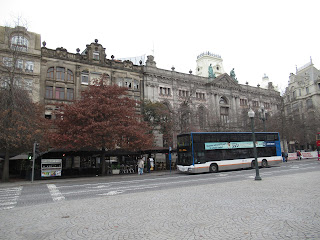



























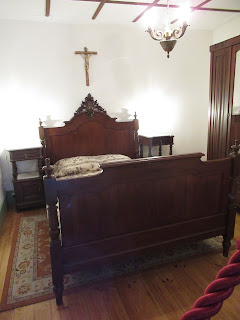








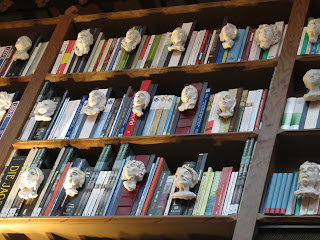

















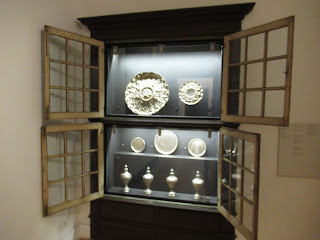








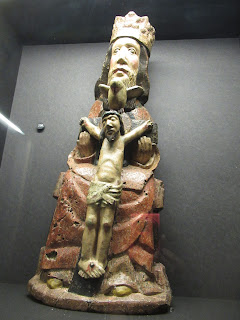







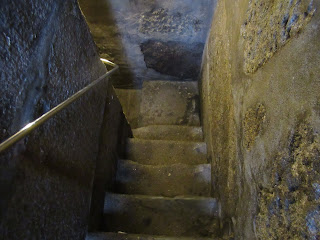






















"while foolish me decided to climb all 225 steps to the top of the tower", what a wonderful view of the inside of the lovely church. Janina
ReplyDeleteI was glad I made the effort to climb to the top of the Clerigos Tower, Janina, as I had the unexpected bonus of viewing the museum en route which made the climb less onerous, too!
ReplyDelete